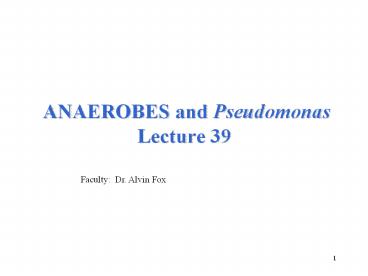ANAEROBES and Pseudomonas Lecture 39 - PowerPoint PPT Presentation
1 / 42
Title:
ANAEROBES and Pseudomonas Lecture 39
Description:
Title: ANAEROBES AND PSEUDOMONAS - OPPORTUNISTIC INFECTIONS Author: Karen F. Fox Last modified by: afox Created Date: 8/10/2000 2:54:44 PM Document presentation format – PowerPoint PPT presentation
Number of Views:141
Avg rating:3.0/5.0
Title: ANAEROBES and Pseudomonas Lecture 39
1
ANAEROBES and Pseudomonas Lecture 39
Faculty Dr. Alvin Fox
2
MAJOR POINTS
Overview of anaerobic bacteriology
Anaerobic non-spore formers
Anaerobic spore formers (clostridia)
Pseudomonas (a strict aerobe)
3
KEY WORDS
- Obligate anaerobes
- Strict anaerobes
- Polymicrobic (mixed) infection
- Spore formers
- Non-spore formers
- Bacteroides
- B. fragilis
- Clostridium tetani
- - tetanospasmin
- C. perfringens
- - a toxin (lecithinase phospholipase)
- C. perfringens
- - enterotoxin
- C. botulinum
- - botulinum toxin
- C. difficile
- - exotoxin A (cytotoxin)
- Pseudomonas aeruginosa
- - pyocyanin
- - pyroverdin
- - exotoxin A
4
Obligate anaerobes
- no oxidative phosphorylation
- fermentation
- killed by oxygen
- lack certain enzymes
- superoxide dismutase
- O2-2H H2O2
- catalase
- H2O2 H20 O2
- peroxidase
- H2O2 NADH H 2H20 NAD
5
Polymicrobic anaerobic infection
- Many species in human flora
- Many grow simultaneously - opportunistic
- conditions
- opportunistic growth
- injured tissue
- limited blood/O2
- no growth
- healthy tissues
- high O2 content
6
Polymicrobic anaerobic infection
- Simultaneous infection with facultative
anaerobe - diminishes O2 supply further
- aids growth of obligate anaerobes
7
Endogenous versus exogenous infection
- Two sources
- normal human flora
- endogenous
- environment (e.g. soil)
- exogenous
8
Source of spore-formers and non-spore formers
- Spore-formers (clostridia)
- exotoxins
- common in the environment (e.g. soil)
- found in normal flora
- Non - spore-formers
- no exotoxins
- mostly normal flora
9
Sites of anaerobes in normal flora
- intestine
- major site
- 95-99 total bacterial mass
- mouth
- genitourinary tract
10
Bacteroides fragilis
- minor component of gut flora
- most common (strict) anaerobic infection after
abdominal surgery
11
- Enterobacteriaceae (facultative anaerobes)
- commonly cause disease
- low numbers gut flora
- Strict anaerobes
- much less commonly cause disease
- high numbers gut flora
- .
12
Strict anaerobe infectious disease
- Sites throughout body
- Muscle, cutaneous/sub-cutaneous necrosis
- abscesses
13
Problems in identification of anaerobic
infections
- air in sample (sampling, transportation)
- no growth
- identification takes several days or longer
- limiting usefulness
- often derived from normal flora
- sample contamination can confuse
14
LABORATORY IDENTIFICATION
- BIOCHEMICAL KITS
- - e.g. substrate utilization
- GAS CHROMATOGRAPHY
- volatile fermentation products
15
ANAEROBIC NON-SPORE-FORMERS OF CLINICAL
IMPORTANCE
Bacteroides e.g. B. fragilis Fusobacterium,
Porphyromonas, Prevotella
Gram-negative rods
Gram-positive rods Actinomyces,
Bifidobacterium, Eubacterium Lactobacillus,
Mobiluncus, Propionibacterium
Gram-positive cocci
Peptostreptococcus and Peptococcus
Gram-negative cocci Veillonella
16
Bacteroides fragilis
- Major disease causing strict anaerobic
- non-spore-former
- Prominent capsule
- anti-phagocytic
- abscess formation
- Endotoxin
- low toxicity
- structure different than other lipolysaccharide
- beta lactamase
17
ANAEROBIC SPORE-FORMERS (CLOSTRIDIA)
- Gram-positive rods
- human intestine
- soil
18
Clostridium tetani
spore
vegetative
19
Clostridium tetani
- Non-invasive
20
Tetanospasmin
- disseminates systemically
- binds to ganglioside receptors
- inhibitory neurones in CNS, signal stopped
- muscles keep on working
- spastic (rigid) paralysis
- glycine, neurotransmitter
21
A severe case of tetanus. muscles, back and
legs are rigid muscle spasms can break bones
can be fatal (e.g respiratory failure)
22
Vaccination
- infant
- DPT (diptheria, pertussis, tetanus)
- tetanus extremely uncommon in US
- tetanus toxoid
- antigenic
- no exotoxic activity
23
C. perfringens
- soil, fecal contamination
- especially in war
- gas gangrene
- - swelling of tissues
- - gas release (fermentation products)
- - tissue destruction (see next slide)
24
a toxin
- tissue degrading enzymes
- a toxin (lecithinase, phospholipase)
- destruction of blood vessels
- myonecrosis
- anaerobic environment created
- organism spreads
25
Without treatment death occurs within 2 days
- effective antibiotic therapy
- debridement
- anti-toxin
- amputation death is rare
26
Laboratory identification
- lecithinase production
27
Food poisoning
- enterotoxin producing strains
28
C. botulinum
29
Botulism
- food poisoning
- rare
- fatal
- germination of spore
- inadequately sterilized canned food
- home
- not an infection
30
Botulinum toxin
- binds peripheral nerve receptors
- acetylcholine neurotransmitter
- inhibits nerve impulses
- flaccid paralysis
- death
- respiratory
- cardiac failure
31
Infection with C. botulinum
- Neonatal botulism
- uncommon
- the predominant form of botulism
- colonization occurs
- limited normal flora to compete
- unlike adult
32
Wounds
- extremely rare
- an infection
33
Botulinum toxin
- Bioterrorism
- not an infection
- resembles a chemical attack
34
Treatment
- anti-toxin
- antibiotic therapy (if infection)
35
C. difficile
- pseudomembanous colitis
- after antibiotic use
- intestinal normal flora
- greatly decreased
- colonization occurs
- exotoxin A (enterotoxin, cytoxin)
- - most potent
- exotoxin B
- - secondary (also a cytoxin)
36
Therapy
- discontinuation of initial antibiotic (e.g.
ampicillin) - specific antibiotic therapy (e.g. vancomycin)
37
PSEUDOMONAS AERUGINOSA
Gram negative rod
38
Pseudomonas
- Aerobic
- Gram-negative rod
- majority of human infections
- P. aeruginosa
39
Common in the environment
- water
- air
- soil
40
P. aeruginosa and compromised host
- Burns and wounds
- destruction of blood vessels
- phagocyte access limited
- cancer
- cytotoxic drugs
- destroy the immune system
- cystic fibrosis
- altered respiratory epithelium
- pneumonia
- .
41
Identification
- Pigments
- pyocyanin (blue-green)
- pyoverdin (green-yellow, fluorescent)
- biochemical reactions
- cultures have fruity smell
42
Pathogenesis
- Slime layer is anti-phagocytic
- Toxin A - ADP ribosylates EF2
- similar to diphtheria toxin

